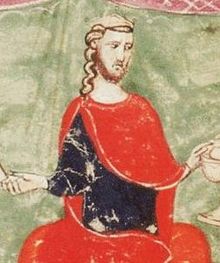Pere III of Aragon
| Peter III | |
|---|---|

|
|
| King of Aragon and Valencia Count of Barcelona |
|
| Reign | 27 July 1276 – 11 November 1285 |
| Coronation | November 1276 (Zaragoza) |
| Predecessor | James I |
| Successor | Alfonso III |
| King of Sicily | |
| Reign | 4 September 1282 – 11 November 1285 |
| Coronation | 9 November 1282 (Palermo) |
| Predecessor | Charles I |
| Successor | James II |
| Born | c. 1239 Valencia |
| Died | 11 November 1285 (aged 45–46) Vilafranca del Penedès |
| Burial | Santes Creus |
| Consort | Constance of Sicily |
| Issue |
Alfonso III, King of Aragon James II, King of Aragon Elisabeth, Queen of Portugal Frederick II, King of Sicily Yolanda, Duchess of Calabria |
| House | House of Barcelona |
| Father | James I of Aragon |
| Mother | Violant of Hungary |
| Religion | Roman Catholicism |
Peter the Great (Catalan: Pere el Gran, Aragonese: Pero lo Gran; 1239 – 11 November 1285) was the King of Aragon (as Peter III) of Valencia (as Peter I), and Count of Barcelona (as Peter II) from 1276 to his death, (this union of kingdoms was called the Crown of Aragon). At the invitation of some rebels, he conquered Sicily and became its king in 1282, pressing the claim of his wife, Constance of Hohenstaufen, uniting the kingdom to the crown. He was one of the greatest of medieval Aragonese monarchs.
Peter was the eldest son of James I of Aragon and his second wife Violant of Hungary. Among (opportunistic) betrothals of his youth, he was betrothed to Eudoxia Laskarina, the youngest daughter of Emperor Theodoros II of Nicaea, in or before 1260. This contract was dissolved, however, after Eudoxia's brother lost the imperial throne in 1261, and Eudoxia was instead married to the Count of Tenda. On 13 June 1262, Peter married Constance, daughter and heiress of Manfred of Sicily. During his youth and early adulthood, Peter gained a great deal of military experience in his father's wars of the Reconquista against the Moors.
On James I's death in 1276, the lands of the Crown of Aragon were divided amongst his two sons. The Kingdom of Aragon, the Kingdom of Valencia and the Catalan counties went to Peter III as being the eldest son; while the Kingdom of Majorca (actual Balearic Islands) and the Catalan counties beyond the Pyrenees of Rousillon-Vallespir, Conflent and Capcir and the lordship of Montpellier (all his territories in the Languedoc), went to the second son, who became James II of Majorca.
...
Wikipedia
